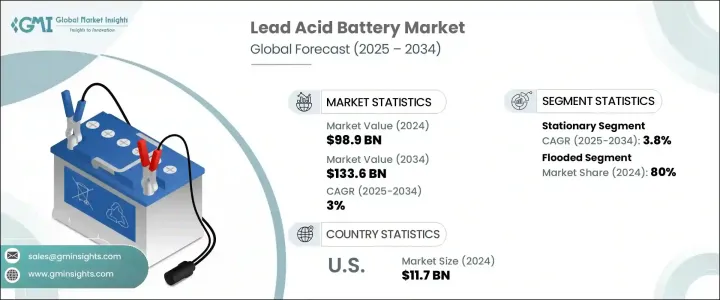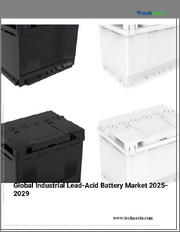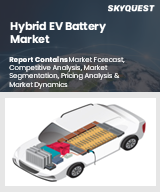
|
시장보고서
상품코드
1766347
납축전지 시장 : 시장 기회, 성장 촉진요인, 산업 동향 분석, 예측(2025-2034년)Lead Acid Battery Market Opportunity, Growth Drivers, Industry Trend Analysis, and Forecast 2025 - 2034 |
||||||
세계의 납축전지 시장 규모는 2024년 989억 달러에 달했고, CAGR 3%로 성장할 전망이며, 2034년 1,336억 달러에 이를 것으로 추정됩니다.
이 꾸준한 성장의 원동력이 되고 있는 것은 강화된 침수형 전지와 흡수 유리 매트(AGM) 기술에 있어서 지속적인 기술 혁신이며, 이들은 스타트 스톱 시스템 및 기타 자동차 보조 기능의 효율을 향상시키고 있습니다. 탄소강화 첨가제나 칼슘 합금 그리드 등의 전극 재료에 있어서 최근의 진보로 도전성이 대폭 향상되고 방전 능력이 강화되어 전지 전체의 수명이 연장되었습니다. 이러한 개선에 의해, 극단적인 온도에서도 안정된 성능을 발휘하는 것이 불가결한 산업, 전기 통신, 에너지 분야에서의 채용이 확대되고 있습니다.

신흥 시장에서 배터리 생산 설비에 대한 투자가 증가함에 따라 납축전지 기술에 대한 액세스도 계속해서 향상되고 있습니다. 이러한 전지는, 신재생 에너지 시스템과의 통합이 진행되고 있으며, 특히 오프 그리드나 원격지의 환경에서, 수요 및 공급의 밸런스를 취하기 위한 신뢰성 높은 스토리지 솔루션으로서의 역할을 완수하고 있습니다. 비용 대비 효과, 재활용성, 오랜 실적으로부터, 산업용 및 주택용 에너지 저장의 양쪽 모두에서 환경 친화적인 솔루션이 되고 있습니다. 게다가 신흥국에서 자동차 제조 증가는, 시동, 조명, 점화(SLI) 배터리의 수요를 끌어올리고 있습니다.
| 시장 범위 | |
|---|---|
| 시작 연도 | 2024년 |
| 예측 연도 | 2025-2034년 |
| 시작 금액 | 989억 달러 |
| 예측 금액 | 1,336억 달러 |
| CAGR | 3% |
거치형 납축전지 분야는 데이터 집약적인 환경에서 중단 없는 안정적인 전력 공급에 대한 수요가 증가함에 따라 2034년까지 연평균 복합 성장률(CAGR) 3.8%를 보일 것으로 예측됩니다. 디지털 인프라의 급속한 개발은 5G 네트워크의 가속화와 함께 비용 효율적이고 신뢰할 수 있는 에너지 저장 솔루션에 대한 강한 수요를 창출하고 있습니다. 이러한 배터리는 정전 및 송전망 변동 시 안정적인 전력 공급을 보장함으로써 통신 네트워크, 긴급 시스템, 데이터센터 및 기타 미션 크리티컬 작업을 지원하는 데 중요한 역할을 합니다. 장기간의 백업, 낮은 유지 보수 요구 사항, 다양한 백업 시스템과의 호환성을 제공하는 능력은 지속적인 시장 관련성에 기여합니다.
VRLA(밸브 제어 납축전지) 분야는 산업 셋업과 중요 시설에 널리 통합되어 있는 것이 원동력이 되어 2034년까지 250억 달러에 이를 것으로 예측되고 있습니다. 이러한 배터리는 밀폐된 유지보수 프리 설계와 뛰어난 충전 유지성으로 지지되며, 밀폐된 시설이나 접근 제한이 있는 시설에 적합합니다. VRLA 배터리는 고스트레스 조건에서도 신뢰성 높은 성능을 발휘하는 실적이 있기 때문에 헬스케어, IT 인프라, 에너지 관리 등 높은 가동률이 요구되는 산업에서 필수적인 존재가 되고 있습니다. 세계의 산업에서 자동화 및 원격 감시 시스템의 도입이 진행되는 가운데, 효율적이고 페일 세이프한 전원 백업을 실현하는 VRLA 배터리의 수요는 증가 일로를 걷고 있습니다.
미국 납축전지의 2024년 시장 규모는 117억 달러로 자동차, 산업기계, 신재생에너지 발전, 비상용 전원 시스템 등에서의 광범위한 사용에 의한 왕성한 수요를 나타내고 있습니다. 이 성장은 납축전지가 제공하는 저렴한 가격, 신뢰성, 재활용성의 비할 데 없는 균형에 의해 뒷받침되고 있습니다. 규제 당국의 감독도 강화되고 있으며, 전지 제조업체에는 새로운 환경 성능 벤치마크가 도입되어 다양한 생산 공정에서 납 배출을 엄격하게 관리하고 있습니다.
납축전지 시장에 적극적으로 참여하고 있는 주목할만한 기업으로는 GS Yuasa International, Furukawa Battery, Zibo Torch Energy, East Penn Manufacturing Company, Amara Raja Group, EnerSys, Leoch International Technology, Narada Power, MUTLU, B.B. Battery, Clarios, NorthStar Battery, Exide Industries, First National Battery, Middle East Battery, C&D Technologies, HOPPECKE Battery, Crown Battery, Shandong Sacred Sun Power Sources, and Chaowei Power Holdings 등이 있습니다. 납 축전지 시장에서 기업이 채용하고 있는 주요 전략은 기술적인 업그레이드나 설계의 개선에 의한 제품 포트폴리오의 강화입니다. 많은 기업들이 연구개발에 투자하여 급속충전, 라이프사이클 연장, 에너지 밀도 향상을 지원하는 고성능 배터리를 개발하고 있습니다. 각사는 또, 에너지 및 자동차에 대한 수요가 높아지는 지역에서의 제조 거점 확대에도 주력하고 있습니다. 전략적 파트너십, 합병, 합작 사업은 지역 침투 및 시장 점유율을 확대하기 위한 일반적인 접근 방식입니다.
목차
제1장 조사 방법 및 범위
제2장 주요 요약
제3장 업계 인사이트
- 생태계 분석
- 규제 상황
- 업계에 미치는 영향요인
- 성장 촉진요인
- 업계의 잠재적 위험 및 과제
- 성장 가능성 분석
- Porter's Five Forces 분석
- PESTEL 분석
제4장 경쟁 구도
- 서문
- 기업의 시장 점유율 분석
- 전략적 대시보드
- 전략적 노력
- 경쟁 벤치마킹
- 혁신 및 지속가능성의 정세
제5장 시장 규모 및 예측 : 용도별(2021-2034년)
- 주요 동향
- 거치형
- 통신
- UPS
- 제어 및 스위치기어
- 기타
- 동기
- SLI
- 자동차
- 오토바이
제6장 시장 규모 및 예측 : 건설별(2021-2034년)
- 주요 동향
- 홍수
- VRLA
- AGM
- GEL
제7장 시장 규모 및 예측 : 판매 채널별(2021-2034년)
- 주요 동향
- OEM
- 애프터마켓
제8장 시장 규모 및 예측 : 지역별(2021-2034년)
- 주요 동향
- 북미
- 미국
- 캐나다
- 유럽
- 독일
- 영국
- 프랑스
- 러시아
- 이탈리아
- 스페인
- 오스트리아
- 네덜란드
- 스웨덴
- 아시아태평양
- 중국
- 일본
- 인도
- 한국
- 호주
- 인도네시아
- 말레이시아
- 태국
- 필리핀
- 베트남
- 싱가포르
- 중동 및 아프리카
- 사우디아라비아
- 아랍에미리트(UAE)
- 이란
- 이집트
- 튀르키예
- 모로코
- 남아프리카
- 나이지리아
- 알제리
- 라틴아메리카
- 브라질
- 아르헨티나
- 멕시코
- 칠레
제9장 기업 프로파일
- Amara Raja Group
- BB Battery
- C&D Technologies
- Chaowei Power Holdings
- Clarios
- Crown Battery
- East Penn Manufacturing Company
- EnerSys
- Exide Industries
- First National Battery
- Furukawa Battery
- GS Yuasa International
- HOPPECKE Battery
- Leoch International Technology
- Middle East Battery
- MUTLU
- Narada Power
- NorthStar Battery
- Shandong Sacred Sun Power Sources
- Zibo Torch Energy
The Global Lead Acid Battery Market was valued at USD 98.9 billion in 2024 and is estimated to grow at a CAGR of 3% to reach USD 133.6 billion by 2034. This steady growth is fueled by ongoing innovations in enhanced flooded batteries and absorbent glass mat (AGM) technology, which offer improved efficiency for start-stop systems and other auxiliary automotive functions. Modern advancements in electrode materials, such as carbon-enhanced additives and calcium-alloy grids, have significantly boosted conductivity, enhanced discharge capabilities, and extended overall battery life. These improvements are driving broader adoption across industrial, telecom, and energy sectors, where consistent performance in extreme temperatures is essential.

As investment into battery production facilities increases across emerging markets, accessibility to lead acid battery technology continues to improve. These batteries are increasingly integrated with renewable energy systems, serving as reliable storage solutions to balance supply and demand, especially in off-grid or remote settings. Their cost-effectiveness, recyclability, and long-standing track record make them an eco-friendly solution for both industrial and residential energy storage. Moreover, rising vehicle manufacturing in developing countries is pushing up demand for starting, lighting, and ignition (SLI) batteries, as they remain the preferred choice for internal combustion engine-powered vehicles.
| Market Scope | |
|---|---|
| Start Year | 2024 |
| Forecast Year | 2025-2034 |
| Start Value | $98.9 Billion |
| Forecast Value | $133.6 Billion |
| CAGR | 3% |
The stationary lead acid battery segment is expected to grow at a CAGR of 3.8% through 2034, driven by the increasing demand for uninterrupted and stable power supply across data-intensive environments. The rapid development of digital infrastructure, along with the accelerated rollout of 5G networks, is creating strong demand for cost-effective and reliable energy storage solutions. These batteries play a crucial role in supporting telecommunication networks, emergency systems, data centers, and other mission-critical operations by ensuring consistent power availability during outages or grid fluctuations. Their ability to provide long-duration backup, low maintenance requirements, and compatibility with diverse backup systems contributes to their continued market relevance.
The VRLA (valve-regulated lead acid) battery segment is projected to reach USD 25 billion by 2034, fueled by widespread integration in industrial setups and essential facilities. These batteries are favored for their sealed, maintenance-free design and excellent charge retention, which make them suitable for enclosed or limited-access installations. With their track record of delivering reliable performance under high-stress conditions, VRLA batteries are becoming indispensable in industries that demand high uptime, such as healthcare, IT infrastructure, and energy management. As global industries increasingly adopt automation and remote monitoring systems, the demand for VRLA batteries continues to climb due to their ability to deliver efficient and fail-safe power backup.
United States Lead Acid Battery Market generated USD 11.7 billion in 2024, showing robust demand driven by widespread use in automobiles, industrial machinery, renewable energy storage, and emergency power systems. This growth is supported by the unmatched balance of affordability, reliability, and recyclability that lead acid batteries offer. Regulatory oversight has also intensified, as new environmental performance benchmarks have been introduced for battery manufacturers, placing tighter control over lead emissions across various production processes.
Noteworthy companies actively participating in the Lead Acid Battery Market include GS Yuasa International, Furukawa Battery, Zibo Torch Energy, East Penn Manufacturing Company, Amara Raja Group, EnerSys, Leoch International Technology, Narada Power, MUTLU, B.B. Battery, Clarios, NorthStar Battery, Exide Industries, First National Battery, Middle East Battery, C&D Technologies, HOPPECKE Battery, Crown Battery, Shandong Sacred Sun Power Sources, and Chaowei Power Holdings. Key strategies adopted by companies in the lead acid battery market center on strengthening their product portfolios through technological upgrades and design improvements. Many firms are investing in R&D to develop high-performance batteries that support fast charging, extended lifecycle, and enhanced energy density. Companies are also focusing on expanding their manufacturing footprints in regions with growing energy and automotive demands. Strategic partnerships, mergers, and joint ventures are common approaches to increase regional penetration and market share.
Table of Contents
Chapter 1 Methodology & Scope
- 1.1 Research design
- 1.2 Market estimates & forecast parameters
- 1.3 Forecast calculation
- 1.4 Data sources
- 1.4.1 Primary
- 1.4.2 Secondary
- 1.4.2.1 Paid
- 1.4.2.2 Public
- 1.5 Market definitions
Chapter 2 Executive Summary
- 2.1 Industry synopsis, 2021 - 2034
Chapter 3 Industry Insights
- 3.1 Industry ecosystem analysis
- 3.2 Regulatory landscape
- 3.3 Industry impact forces
- 3.3.1 Growth drivers
- 3.3.2 Industry pitfalls & challenges
- 3.4 Growth potential analysis
- 3.5 Porter's analysis
- 3.5.1 Bargaining power of suppliers
- 3.5.2 Bargaining power of buyers
- 3.5.3 Threat of new entrants
- 3.5.4 Threat of substitutes
- 3.6 PESTEL analysis
Chapter 4 Competitive Landscape, 2025
- 4.1 Introduction
- 4.2 Company market share analysis, 2024
- 4.3 Strategic dashboard
- 4.4 Strategic initiatives
- 4.5 Competitive benchmarking
- 4.6 Innovation & sustainability landscape
Chapter 5 Market Size and Forecast, By Application, 2021 - 2034 (USD Million & Million Units)
- 5.1 Key trends
- 5.2 Stationary
- 5.2.1 Telecommunications
- 5.2.2 UPS
- 5.2.3 Control & switchgear
- 5.2.4 Others
- 5.3 Motive
- 5.4 SLI
- 5.4.1 Automobiles
- 5.4.2 Motorcycles
Chapter 6 Market Size and Forecast, By Construction, 2021 - 2034 (USD Million & Million Units)
- 6.1 Key trends
- 6.2 Flooded
- 6.3 VRLA
- 6.3.1 AGM
- 6.3.2 GEL
Chapter 7 Market Size and Forecast, By Sales Channel, 2021 - 2034 (USD Million & Million Units)
- 7.1 Key trends
- 7.2 OEM
- 7.3 Aftermarket
Chapter 8 Market Size and Forecast, By Region, 2021 - 2034 (USD Million & Million Units)
- 8.1 Key trends
- 8.2 North America
- 8.2.1 U.S.
- 8.2.2 Canada
- 8.3 Europe
- 8.3.1 Germany
- 8.3.2 UK
- 8.3.3 France
- 8.3.4 Russia
- 8.3.5 Italy
- 8.3.6 Spain
- 8.3.7 Austria
- 8.3.8 Netherlands
- 8.3.9 Sweden
- 8.4 Asia Pacific
- 8.4.1 China
- 8.4.2 Japan
- 8.4.3 India
- 8.4.4 South Korea
- 8.4.5 Australia
- 8.4.6 Indonesia
- 8.4.7 Malaysia
- 8.4.8 Thailand
- 8.4.9 Philippines
- 8.4.10 Vietnam
- 8.4.11 Singapore
- 8.5 Middle East & Africa
- 8.5.1 Saudi Arabia
- 8.5.2 UAE
- 8.5.3 Iran
- 8.5.4 Egypt
- 8.5.5 Turkey
- 8.5.6 Morocco
- 8.5.7 South Africa
- 8.5.8 Nigeria
- 8.5.9 Algeria
- 8.6 Latin America
- 8.6.1 Brazil
- 8.6.2 Argentina
- 8.6.3 Mexico
- 8.6.4 Chile
Chapter 9 Company Profiles
- 9.1 Amara Raja Group
- 9.2 B.B. Battery
- 9.3 C&D Technologies
- 9.4 Chaowei Power Holdings
- 9.5 Clarios
- 9.6 Crown Battery
- 9.7 East Penn Manufacturing Company
- 9.8 EnerSys
- 9.9 Exide Industries
- 9.10 First National Battery
- 9.11 Furukawa Battery
- 9.12 GS Yuasa International
- 9.13 HOPPECKE Battery
- 9.14 Leoch International Technology
- 9.15 Middle East Battery
- 9.16 MUTLU
- 9.17 Narada Power
- 9.18 NorthStar Battery
- 9.19 Shandong Sacred Sun Power Sources
- 9.20 Zibo Torch Energy



















